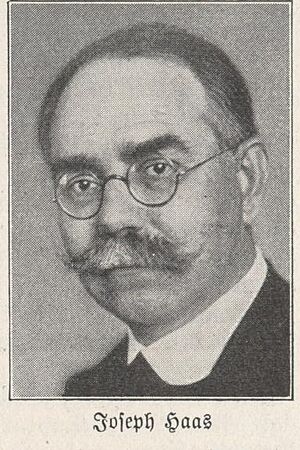Joseph Haas facts for kids
Joseph Haas (born March 19, 1879 – died March 30, 1960) was a German composer and music teacher. He lived during the late Romantic period in music, which was a time when composers focused on strong emotions and grand sounds.
Biography
Joseph Haas was born in Maihingen, a town near Nördlingen, Germany. His father, Alban Haas, was a teacher. Joseph became interested in music at a young age. He followed in his father's footsteps and became a teacher himself, working from 1897 to 1904 in Lauingen, a town near the Danube River.
Joseph Haas wanted to learn more about music. In 1904, he met a famous composer named Max Reger in Munich. Haas took private music lessons from Reger. In 1907, he followed Reger to Leipzig to study music at the Leipzig Conservatory. He finished his studies in 1909.
Haas began to have success as a composer. In 1911, he won a special scholarship. He then became a composition teacher at the Stuttgart Conservatory. By 1916, he was made a professor there. In 1921, he started teaching at the Akademie für Tonkunst in Munich, which is now called the Hochschule für Musik und Theater München. He became a professor there in 1924 and taught until 1950.
In 1921, Joseph Haas helped start an important music event. He worked with Paul Hindemith and Heinrich Burkard to create the Donaueschingen Festival. This festival helped new and modern music be heard. In 1930, he became a member of the Prussian Academy of Arts in Berlin.
After World War II, Joseph Haas became the president of the Munich Hochschule für Musik und Theater. He helped rebuild the school after the war. He held this important position until 1950, when he retired as an Emeritus Professor. Joseph Haas passed away in Munich and was buried in the Munich Waldfriedhof cemetery.
Importance in Music
As a Composer
Joseph Haas's music was always based on tonality. This means his music used clear musical keys and harmonies, rather than more experimental sounds. At first, his teacher Max Reger greatly influenced him. Haas's music often showed Reger's style of polyphony (many independent melodies played together) and harmony (how different notes sound good together).
During his lifetime, Haas was a very successful and well-known composer. When he turned 75 in 1954, many celebrations were held for him across both West and East Germany. However, after he died, his music was played less often in concerts. In 1949, his friend Rupert Egenberger created the Joseph-Haas-Gesellschaft. This group was dedicated to celebrating Haas and his musical works.
Selected Works
Stage Works
- Die Bergkönigin (op. 70; 1927), music for a Christmas play
- Tobias Wunderlich (op. 90; 1934–37), an opera in 3 acts. It first played on November 24, 1937.
- Die Hochzeit des Jobs (op. 93; 1940–43), a funny opera in 4 acts. It first played on July 2, 1944.
Oratorios (large musical pieces for choir and orchestra, usually telling a story)
- Die heilige Elisabeth (op. 84)
- Christnacht (op. 85)
- Das Lebensbuch Gottes (op. 87)
- Das Lied von der Mutter (op. 91)
- Das Jahr im Lied (op. 103)
- Die Seligen (op. 106)
Song Cycles (groups of songs meant to be performed together)
- Sechs Krippenlieder (op. 49)
- Unterwegs (op. 65) based on poems by Hermann Hesse
- Gesänge an Gott (op. 68) based on poems by Jakob Kneip
Masses and Sacred Music (music for religious services)
- Eine Deutsche Singmesse (op. 60)
- Speyerer Domfestmesse (op. 80)
- Christ-König-Messe (op. 88)
- Münchener Liebfrauenmesse (op. 96)
- Te Deum (op. 100)
- Totenmesse (op. 101)
- Deutsche Weihnachtsmesse (op. 105)
- Deutsche Chormesse (op. 108)
Orchestral Works (music for a full orchestra)
- Heitere Serenade (op. 41)
- Variationen und Rondo über ein altdeutsches Volkslied (op. 45)
- Variationensuite über ein altes Rokokothema (op. 64)
- Ouvertüre zu einem frohen Spiel (op. 95)
Chamber Music (music for a small group of instruments)
- Streichquartett g-Moll (op. 8) (for string quartet)
- Violinsonate h-Moll (op. 21) (for violin and piano)
- Divertimento D-Dur (op. 22) (for string trio)
- Waldhornsonate F-Dur (op. 29) (for French horn and piano)
- Divertimento C-Dur (op. 30a) (for string quartet)
- Kammertrio a-Moll (op. 38) (for two violins and piano)
- Grillen (op. 40) (for violin and piano)
- Streichquartett A-Dur (op. 50) (for string quartet)
- Kirchensonate F-Dur (op. 62/1) (for violin and organ)
- Kirchensonate d-Moll (op. 62/2) (for violin and organ)
Piano Music
- Wichtelmännchen (op. 27)
- Gespenster (op. 34)
- Hausmärchen (op. 35, op. 43, op. 53)
- Eulenspiegeleien (op. 39)
- Alte unnennbare Tage Elegien für Klavier (op. 42)
- Sonate a-Moll (op. 46)
- Zwei Sonaten (D-Dur, a-Moll) (op. 61)
- Vier Sonatinen (C-Dur, d-Moll, G-Dur, F-Dur) (op. 94)
- Klangspiele, Zehn kleine Stücke für Klavier (op. 99)
Organ Music
- Drei Präludien und Fugen (c-Moll, g-Moll, D-Dur) (op. 11)
- Sonate c-Moll (op. 12)
- Suite d-Moll (op. 20)
- Suite A-Dur (op. 25)
As a Teacher
Joseph Haas was also a very important music teacher. Many of his students became famous composers and conductors themselves. Some of his notable students include:
- Otto Jochum (1898–1969)
- Eugen Jochum
- Karl Amadeus Hartmann
- Karl Höller
- Wolfgang Sawallisch
- Margarete Schweikert



